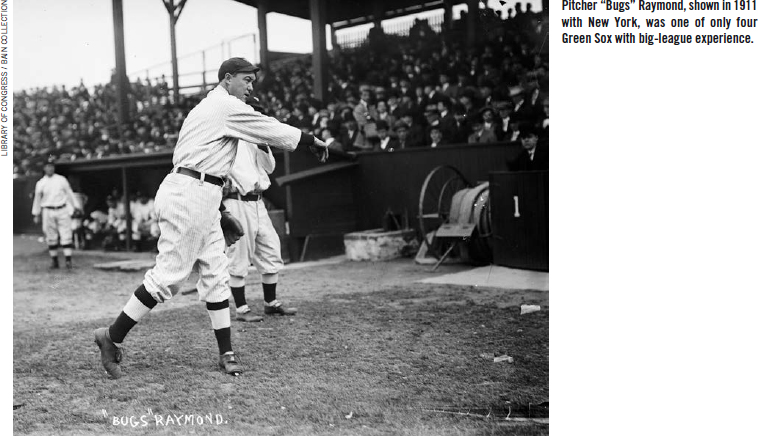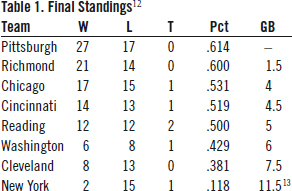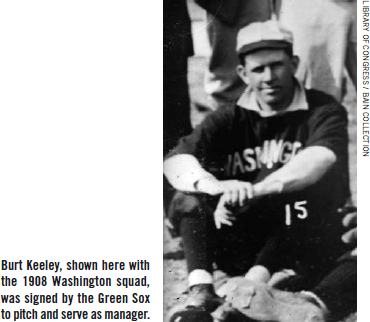The Chicago Green Sox
This article was written by Steven Glassman
This article was published in The National Pastime: Heart of the Midwest (2023)
In 1912, Chicago was under consideration by two upstart baseball leagues. On February 12, John T. Powers’s Columbian League awarded a franchise to Chicago (along with Cleveland, Detroit, Indianapolis, Kansas City, Louisville, Milwaukee, and St. Louis), but the venture failed to materialize due to a lack of money. On April 3, an official announcement was made that Columbian League would not operate in 1912, but might come back in 1913. The United States League was formed on December 21, 1911. Following a March 16 meeting, the league announced that Charles White and his New York franchise had until noon on March 18 to secure a field. A franchise for Chicago was sought by a representative for that city.1 According to the Chicago Tribune, “the majority of the promoters, it is understood, believe Chicago would help to balance the western end of the circuit and that its admission would give the league more prestige. The western men are strong supporters of Chicago.”2 After White failed to meet the deadline, New York was out of the league, to be replaced by either Baltimore, Buffalo, or Chicago. League President William A. Whitman was appointed a committee of one to choose among these three cities.3 He awarded the franchise to Chicago Gunthers owner William C. Niesen on March 23.
In addition to the Green Sox, Chicago newspapers referred to the new team by many names, including the Outlaws, Sams, US Leaguers, US Recruits (during the preseason), and Uncle Sams. The Green Sox played their home games at the 5,000-seat Gunther Park, owned by J.D. Cameron. Originally built in 1905, the park was located at the intersection of Clark Street and Leland Avenue, and served as home for the Chicago City League’s Gunther Nine. The field had a wooden fence in the outfield and a covered grandstand.
On April 5, the Green Sox began their preseason with more than 30 players. Their April 6 debut against the Gunthers at Gunther Park was cancelled due to rain after two innings. On April 7, an intersquad was played between the “Raymonds” and “Keeleys” at Gunther Park. The “Raymonds,” named for pitcher Bugs Raymond, defeated the “Keeleys,” named for pitcher Burt Keeley, 7-5. The preseason schedule included games versus the Gunthers and Chicago American Giants. Keeley signed on as the Green Sox player-manager on April 11. He had previously pitched for the Washington Nationals (1908-09). This was his first manager’s job.
The 126-game schedule was announced in the April 8 Chicago Tribune. Following a league meeting in Pittsburgh, a revised schedule was announced in the April 18 Inter Ocean, with the Green Sox opening the season on the road in Cincinnati on May 1. Their home opener was on May 8 versus Cleveland. The Green Sox were scheduled to finish their season on the road at Cleveland on September 22.
The 15 players announced on May 1 were as follows: Ed McDonough and Daly at catcher.4 The pitchers were Charley Gardner, Tom McGuire, Walter Parker, Henry Paynter (or Painter), and Bugs Raymond. The infielders were Crowley (first), Al Schall (second), Bob Meinke (shortstop), and Herman Walters (third).5 The outfielders were Jim Stanley (left), Lou Gertenrich (center), and “Bibbie” Lynch (right). Handy Andy wrote the following in the May 1 Chicago Tribune: “‘Bugs’ Raymond, who has signed a contract, may not pitch for some time, as he is still on the reserve list of the New York National league [sic] club. Owner Niesen expects to have him in the fold without causing a clash with the supreme body of baseball.”6 Gertenrich, Ernie Johnson, James McDonough, McGuire, and Meinke were Chicago natives. McDonough (Elgin) and Keeley (Wilmington) were Illinois natives. Stanley (Plymouth, Pennsylvania) was the only known player who was born outside of Illinois.
Only four players could boast of major-league experience. Ed McDonough played six games for the Philadelphia Phillies (1909-10). Meinke played two games for the Cincinnati Reds (1910). Gertenrich’s baseball journey began in 1891 as a pitcher with the American Boys team.7 After playing outfield in Milwaukee (1901) and Pittsburgh (1903), he played for the following Chicago City League squads (seasons unknown): Logan Square, Gunthers, Rogers Park, West Ends, Riverviews, and Anson’s Colts. Gertenrich also played for Springfield (Central) and Decatur (Three-I) in 1905.8 In 1909, the Brooklyn Superbas offered Gertenrich an opportunity to play for them while he was playing in the Chicago City League. He was playing for the Gunthers before he was signed by the Green Sox at the age of 36. Raymond’s professional career began in 1903 with Appleton (independent). He pitched in 136 games, including 95 starts, for the Tigers (1904), Cardinals (1907-08), and Giants (1909-11). He was kicked off the Giants due to alcoholism, and was pitching in semi-pro ball in Chicago before signing with the Green Sox.
With the season about to start, Niesen was optimistic about the league’s future. “‘We are on the shady side just now,’ he said last night, ‘but judging from reports from around the circuit, it will not be long before we cross into the sunshine. There is great interest in our league among the fans in the towns, and we hope to have good attendance from the start.’”9 The season began on May 1 for Chicago, Cincinnati, Cleveland, New York, Pittsburgh, Reading, Richmond, and Washington. Pregame festivities in Cincinnati included music, a parade of automobiles, speeches, and Mayor Henry T. Hunt throwing the first pitch. The Green Sox won the season opener, 5-4, in front of 5,000 Cincinnatians. Meinke sent a ninth-inning single into left field, driving in McDonough for the go-ahead run. Raymond lost in his debut on May 2, 6-5. The Green Sox next traveled to Cleveland, ending their two-city road trip 1-3-1 with one rainout.
Before the home opener on May 8, Chicago Mayor Carter H. Harrison II and Illinois Democratic gubernatorial candidate Edward F. Dunne led an auto parade including aldermen and local politicians down Clark Street from Hotel Sherman to Gunther Park. Despite scoring five runs in the bottom of the fourth and leading 8-4 in the eighth, the Green Sox fell 15-8 to Cleveland. Cold weather and rainouts hampered Chicago’s early season schedule. Between May 5 and 16, five games were cancelled, including four out of a five-game stretch.
Around the league, poor weather and attendance led to a lack of money, which led to clubs dropping out. Washington disbanded first on May 23. Cleveland followed suit the very next day, as players were quitting because they were not getting paid. David Pietrusza wrote in his book, Major Leagues, “On May 27 New York forfeited a game on its own field to Chicago when just 50 fans showed up. Owner Tom Cronin, a Bronx politician, gave up the next day, and declared the franchise forfeit.”10
On June 1, Reading declared bankruptcy and Richmond dropped out of the league. Marshall Henderson replaced Whitman as league president. Cincinnati disbanded on June 3 and was sued the next day by 14 players who were owed salaries. Chicago resumed its schedule against the remaining teams, Cincinnati and Pittsburgh. The Green Sox played nine more games. On June 23, they defeated the Pittsburgh Filipinos, 9-4, in their last league game. They finished by winning six of their last seven games and ended the season in third place.11
The Green Sox continued to play after the league officially disbanded on June 23. They played against local teams such as the All-Professionals, Cubans, Chicago Giants, Chicago American Giants, Chicago Typos, Fred Schmitt’s (or Schmidt’s) Joliets, Logan Squares, Professionals, Gunthers, Roselands, and West Ends. The July 9 Chicago Tribune and the Inter Ocean mentioned a possible four-team league with the Cubans, Giants, and Americans, but it would have needed approval from the Cubans’ Nat Strong. The Green Sox also played against out-of-state teams including the Cheyenne Indians, Chinese Giants (from Hawaii), Cincinnati (formerly of the United States League), Crawfords, Gary (Indiana), and St. Louis Giants. They last played together on November 3 in a South Side semiprofessional championship series that featured the Green Sox and the All-Professionals at Gunther Park, and the Roseland Eclipses and Woodlawn Ramblers at Roseland.
Raymond, who last pitched for the Green Sox on May 6 against Cleveland, was a spectator at a semiprofessional game in Chicago on September 1. According to the 1913 Reach Official American League Guide, “some one [sic] threw a piece of pottery which struck the pitcher on the face. Raymond picked up the missile and struck [Fred] Cigranz with it, and in the fight that followed, Raymond was knocked down and kicked in the head a number of times.”14 Six days later, Raymond was found dead at Hotel Veley in Chicago “from [a] cerebral hemorrhage due to a fracture of the skull.”15 Some of his Green Sox teammates served as pallbearers at his September 9 funeral. Fred Cigranz was arrested and confessed to murdering Raymond. It is not known how much prison time Cigranz (or Cingrang) served
The Green Sox did not return for the United States League’s second attempt in 1913. New York, Reading, and Washington returned along with newcomers Baltimore, Brooklyn, Lynchburg, Newark (New Jersey), and Philadelphia. The 126-game schedule began on May 10 and was intended to end on September 27. However, the return was short-lived. The season ended on May 12, after just three days.
Chicago returned as part of the Federal League from 1913 to 1915. The team was known as either the Chifeds (Encyclopedia of Minor League Baseball, and also styled the ChiFeds or Chi-Feds), the Keeleys, or the Whales (Baseball-Reference.com). Some of the Green Sox players played for the 1913 team under Keeley: Gertenrich, Lynch, James McDonough, John McDonough, McGuire, Painter, Schall, and Stanley. Their 57-62 record was good for fourth, 171/2 games behind the Indianapolis Hoosierfeds. McGuire and Stanley returned in 1914 under new manager Joe Tinker. James McDonough was on the 1914 Chifeds roster, but did not play.16 The Chifeds finished second at 87-67, just 11/2 games out of first place. None of the Green Sox were on the roster for the first place 1915 team.
McGuire made one appearance for the White Sox in 1919. Johnson had the longest Major League career after the Green Sox. He played 813 games for the White Sox (1912, 1921-23), St. Louis Terriers (1915), St. Louis Browns (1916-18), and the New York Yankees (1923-25).
Gunther Park was abandoned in 1913, shortly before the construction of Wrigley Field.17 It was later turned into a park by the Lincoln Park Commission, and renamed Chase Park, after Treasury Secretary and United States Supreme Court Chief Justice Salmon P. Chase.18 According to the Ravenswood-Lake View Historical Association: “In 1914 the Ravenswood Improvement Association and local residents petitioned the Lincoln Park Commission to convert the former baseball stadium into a public park. The park commission acquired the land in 1920. Within two years tennis courts, a playground, an athletic field, a wading pool and a field house were constructed… The original field house was replaced with the current building in 1976.” A few miles away in Lincoln Park, a fountain was dedicated to William C. Niesen in 1955. Funded by the Old Timers’ Baseball Association, it still stands near the South Athletic field house and Niesen Field.20
STEVEN M. GLASSMAN’s article on the Chicago Green Sox will be his ninth National Pastime article. He previously wrote “Philadelphia’s Other Hall of Famers” (SABR 43), “The Game That Was Not— Philadelphia Phillies at Chicago Cubs (August 8, 1988)” (SABR 45), “Walking it Off (Marlins Postseason Walk-Offs)” (SABR 46), “A Hall of Fame Cup of Coffee in New York” (SABR 47), “Padres’ Near No-Hitters” (SABR 49), “The Baltimore Orioles’ 1971 Japan Trip” (SABR 50), and “The Future of Baseball Cards” (The Future According to Baseball), and “The Hidden Potato Trick” (Major Research on the Minor Leagues). Steven has been a SABR member since 1994. He graduated with a Bachelor of Science Degree in Sport and Recreation Management from Temple University. Originally born in Philadelphia, Steven currently lives in Warminster, Pennsylvania.
Sources
In addition to the sources mentioned in the notes, the author referred to Baseball-Reference, Newspapers.com, and Retrosheet for box scores, play-by-plays, and other pertinent information.
Notes
1. “U.S. League Wants Chicago,” Chicago Tribune, March 17, 1912, 24.
2. “U.S. League Wants Chicago,” Chicago Tribune, March 17, 1912, 24.
3. “No U.S. League Club in Gotham,” Chicago Tribune, March 19, 1912, 11.
4. I could not find a first name for Daly.
5. I could not find a first name for Crowley.
6. Handy Andy, “U.S. League to Start Today,” Chicago Tribune, May 1, 1912, 13.
7. His early amateur, semiprofessional, and professional career also included stops with the Clyburn Juniors (1892), Brands (Chicago City League, 1894), Garden Cities (Chicago City, 1895); Maroons (season unknown), and Auburn Parks (seasons unknown)
8. According to website Baseball History Daily: “For the next four seasons, Gertenrich remained one of Chicago’s best local athletes. At 33-years-old in 1908 he was still a good enough runner to win the City League Field Day title of fastest player; The Daily News said he rounded the bases in 14 and 1/5 seconds.” https://baseballhistorydaily.com/2014/07/07/this-wealth-of-mr-gertenrich-has-cost-the-game-an-a-1-player.
9. “U.S. Leaguers To Open Up Tomorrow,” Chicago Inter Ocean, April 30, 1912, 4.
10. David Pietrusza, Major Leagues Jefferson, NC: McFarland & Co., 1991), 205.
11. The 1913 Reach Official American League Base Ball Guide (Philadelphia: A.J. Reach Company, 1913), 113.
12. The 1913 Reach Official American League Guide’s standings differ. They do not include games that Chicago played against Cincinnati and Pittsburgh after June 3.
14. The 1913 Reach Official American League Base Ball Guide, 113.
15. The 1913 Reach Official American League Base Ball Guide, 113.
16. “Chicago Feds Name Lineup,” Reading Times, March 4, 1914, 8. McDonough was also purportedly rostered by the Cubs but did not play. See Bill Hickman, “Near Major Leaguers,” SABR.org. https://sabr.org/research/article/near-major-leaguers.
17. Ravenswood-Lake View Historical Association, January 9, 2010, https://www.ravenswoodhistorical.com/tag/chicago-green-sox.
18. The Official Website of the Chicago Park District, https://www.chicagoparkdistrict.com/parks-facilities/chase-salmon-park.
19. Ravenswood-Lake View Historical Association.
20. The Official Website of the Chicago Park District, https://www.chicagoparkdistrict.com/parks-facilities/william-c-niesen-memorial-fountain.





